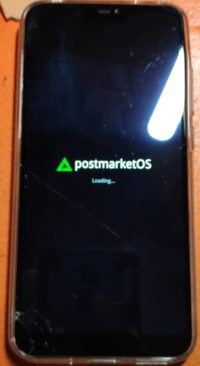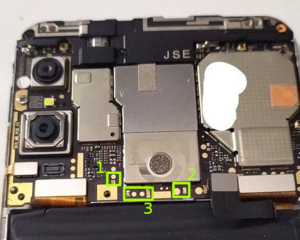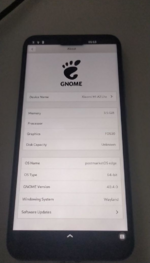Xiaomi Mi A2 Lite (xiaomi-daisy): Difference between revisions
| Line 154: | Line 154: | ||
==== Mobile data ==== | ==== Mobile data ==== | ||
Mobile data works with ipa-lite on 6.7.0/main branch. | |||
To configure the mobile network settings, use NetworkManger (mobile network menu on phosh settings) so it sets up the network interface and IP routing. | To configure the mobile network settings, use NetworkManger (mobile network menu on phosh settings) so it sets up the network interface and IP routing. | ||
Revision as of 19:31, 25 January 2024
 Xiaomi-daisy Booting | |
| Manufacturer | Xiaomi |
|---|---|
| Name | Mi A2 Lite |
| Codename | xiaomi-daisy |
| Released | 2018 |
| Type | handset |
| Hardware | |
| Chipset | Qualcomm Snapdragon 625 (MSM8953) |
| CPU | 2 GHz 8 Core Cortex-A53 |
| GPU | Adreno 506 |
| Display | 1080 x 2280 IPS |
| Storage | 32 GB |
| Memory | 3/4 GB |
| Architecture | aarch64 |
| Software | |
| Original software | Android (MIUI) |
| Original version | 8.1 |
| postmarketOS | |
| Category | community |
| Pre-built images | yes |
| postmarketOS kernel | 6.1.0 |
| Flashing |
Works |
|---|---|
| USB Networking |
Works |
| Internal storage |
No data |
| SD card |
No data |
| Battery |
Works |
| Screen |
Works |
| Touchscreen |
Works |
| Multimedia | |
| 3D Acceleration |
Works |
| Audio |
Works |
| Camera |
Broken |
| Camera Flash |
No data |
| Connectivity | |
| WiFi |
Works |
| Bluetooth |
Works |
| GPS |
Broken |
| NFC |
No data |
| Modem | |
| Calls |
Partial |
| SMS |
Partial |
| Mobile data |
Broken |
| Miscellaneous | |
| FDE |
Works |
| USB OTG |
Works |
| HDMI/DP |
No data |
| Sensors | |
| Accelerometer |
Works |
| Magnetometer |
No data |
| Ambient Light |
No data |
| Proximity |
No data |
| Hall Effect |
No data |
| Haptics |
No data |
| Barometer |
No data |
This device is also known as Xiaomi Redmi 6 Pro (sakura). The only difference is that sakura has MIUI preinstalled instead of stock Android One.
Contributors
- Ash
- Alikates
Users owning this device
- Alikates (Notes: Two devices, one with android and the other with pmOS)
- Ash (Notes: Broken part of screen)
- DiabloSat (Notes: A detailed installation guide with pictures has been written)
- Imre (Notes: struggling to install to sdcard)
- ItsVixano (Notes: Has a non-OEM battery replacement)
- Manut (Notes: edge, phosh)
- Progmetalbg (Notes: running Android One 10)
- Russanandres (Notes: Android 12 Custom)
- Soupborsh (Notes: stable pmOS as server with removed battery)
- Victorbnl
- XVT 360 (Notes: Running pmOS)
Installation
Fastboot Mode
First make sure to enable USB debugging in Android ([1]) Then with device powered off, hold the and buttons simultaneously for a few seconds, until Fastboot Mode screen appears.
OEM Unlock
Get device into Fastboot Mode, plug in USB cable, then:
$ sudo fastboot oem unlock
When prompted on device, use Volume-Up/Down buttons to highlight choice, then Power button to select it. The Fastboot Mode screen will appear again, and a message saying that the device isn't secure will appear briefly.
Installation
Build the image
$ pmbootstrap init
$ pmbootstrap install
Install the image
$ pmbootstrap flasher flash_lk2nd
$ pmbootstrap flasher flash_rootfs
Install to xiaomi-sakura
xiaomi-sakura has rollback protection, some manually steps are needed.
$ fastboot boot lk2nd.img
$ fastboot flash lk2nd lk2nd.img
$ pmbootstrap flasher flash_rootfs
If you want to install pmOS to an SD card instead of internal storage, you need to add --sdcard <device path> at the end of the install command.I.e. (using lk2nd): pmbootstrap install --add msm8953-lkn2d --sdcard /dev/<your_sdcard> |
Mainline Kernel
To use it select mainline kernel when running pmbootstrap init
Flashing lk2nd is needed. ([2]).
Feature table
| Parts | Status | Notes | |
|---|---|---|---|
| Modem | Partial | It works with ipa-lite on 6.7.0/main branch. | |
| WiFi | Works | ||
| Sensors | Partial | Working with i2c-gpio from here. WIP SSC driver here. | |
| GPU | Works | ||
| Audio | Works | Everything works. Speaker works since version 6.4.7. Needs alsa UCM config from this package. | |
| Touchscreen | Works | Both touchscreen variant are supported. | |
| Charger | Works | Driver added in 6.1 | |
| Panel | Partial | Only supported hx8933, ili8707 and otm1911 models (not sure if there are any other panels) |
Modem
Firmware loads and modem boots. It detects SIM card and can be unlocked and configured with qmicli.
Because audio needs more work i couldn't test audio quality on calls but with q6voiced it should work.
Mobile data
Mobile data works with ipa-lite on 6.7.0/main branch.
To configure the mobile network settings, use NetworkManger (mobile network menu on phosh settings) so it sets up the network interface and IP routing.
After that, two new network interfaces should appear. The rmnet one is the connection to the modem, and the other one is virtual and the one that is used to transmit mobile data.
Images
| 1: Tx, 2: GND, 3: EDL test-points |
See also
- Qualcomm Snapdragon 450/625/626/632 (MSM8953)
- pmaports!1687 Initial merge request
- pmaports!2225 Mainline merge request
- Device package
- Kernel package
- Mainline kernel
- lk2nd
- Charger driver fork

